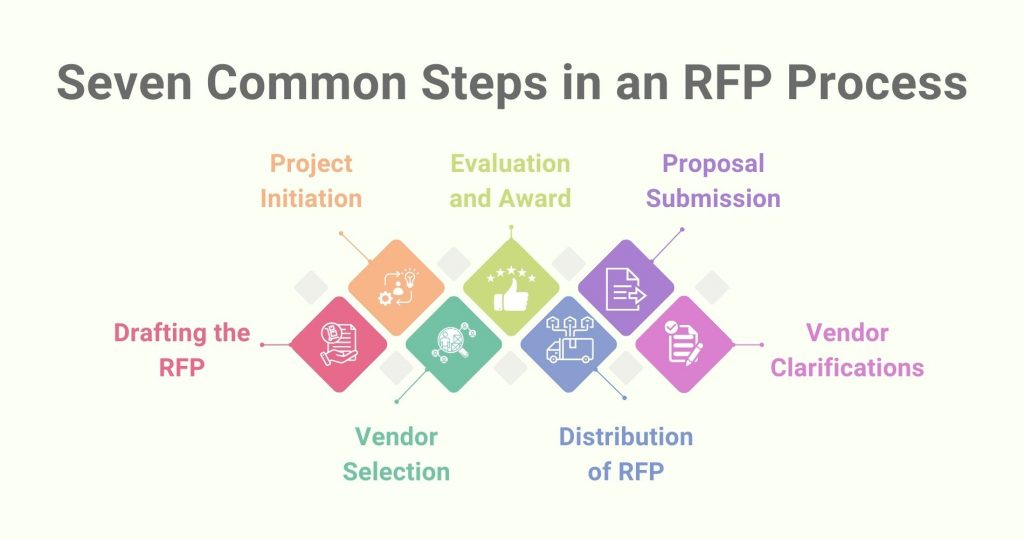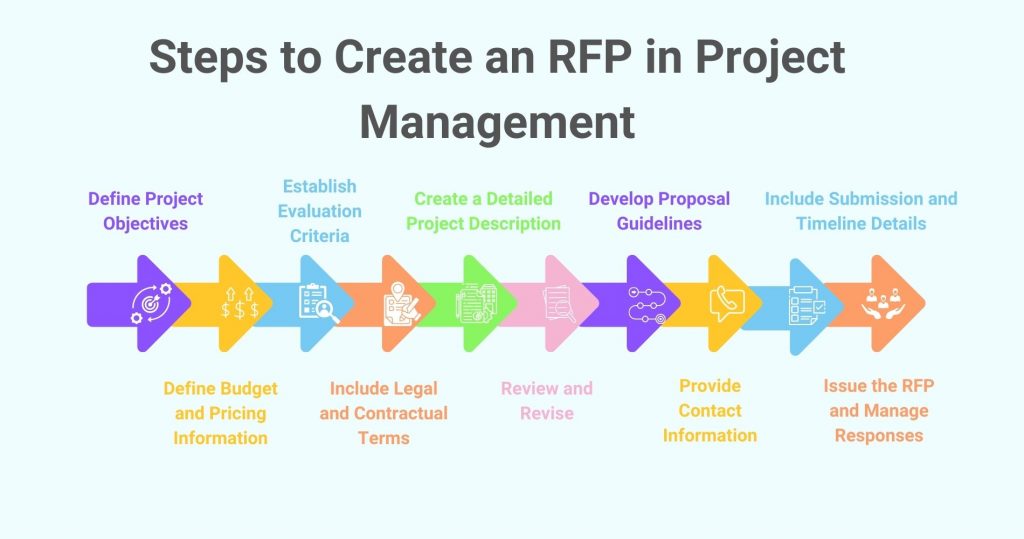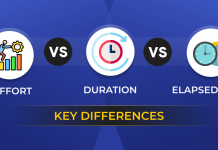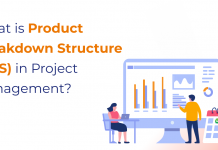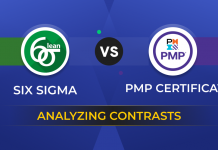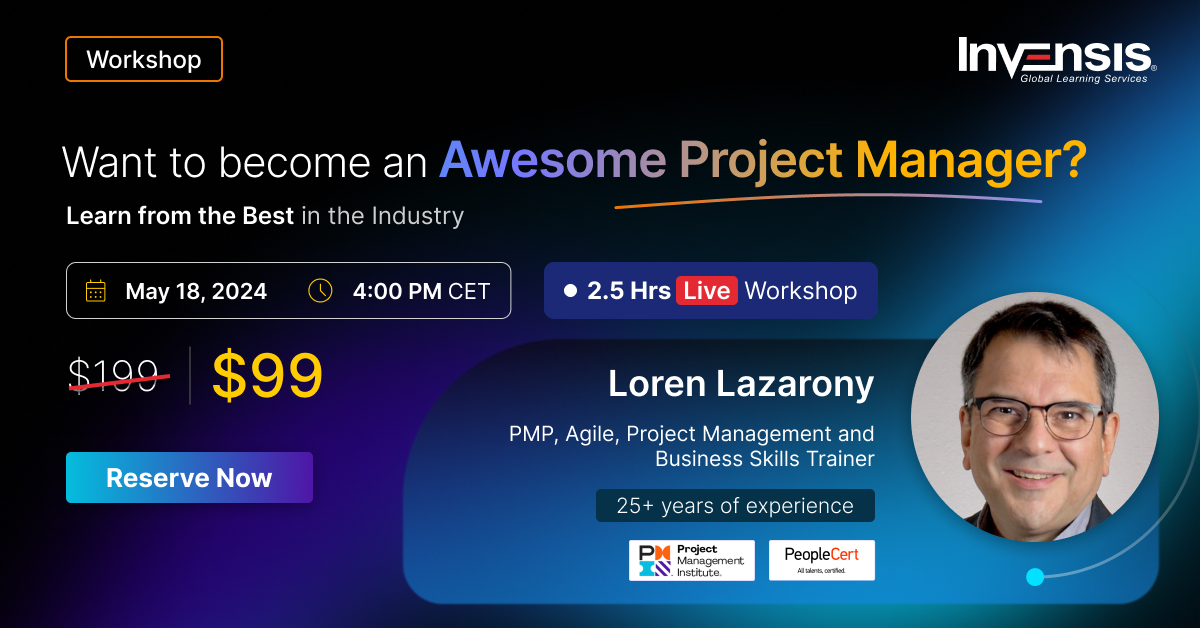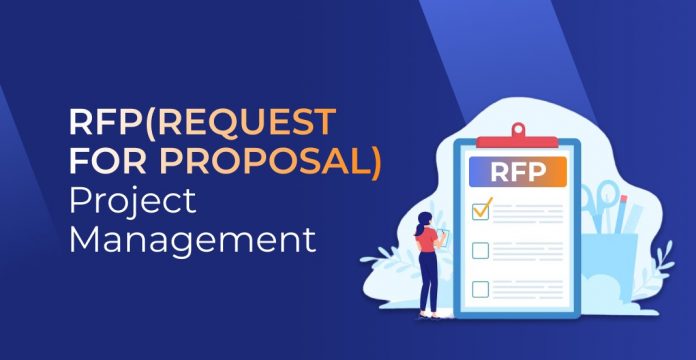
In the domain of project management, the key to seamless project execution lies in effective communication and precise documentation. Request for Proposal or RFP in project management is a fundamental instrument aiding this endeavor.
An RFP, as a systematic procedure, allows companies to seek offers from prospective vendors or service providers, simplifying the procurement process and creating stakeholder alignment.
In this comprehensive blog, we unravel the layers of RFP intricacies, exploring its vital role in project initiation and vendor selection.
Table Of Contents
- What is RFP in Project Management
- 7 Steps in an RFP Process
- Benefits of Using RFP in Project Management
- What is the Format for RFP Project Management?
- How to create an RFP in Project Management?
- RFP Examples
- Conclusion
What is RFP in Project Management?
An RFP, or Request for Proposal, is a formal document organizations create to solicit detailed proposals from potential vendors or service providers. This document outlines the specific requirements, objectives, and expectations the organization has for a particular project.
By issuing an RFP, a project manager or organization can invite bids from various suppliers, allowing them to compare and evaluate proposals based on predetermined criteria such as cost, expertise, timeline, and approach.
The RFP serves several essential purposes in project management:
- Clarity: It provides a clear and detailed overview of the project’s requirements, helping vendors understand what is expected from them
- Standardization: By using a standardized RFP template, organizations ensure that all potential vendors receive the same information, promoting fairness and consistency in the selection process
- Evaluation: RFP responses allow project managers to assess vendors’ capabilities, methodologies, and cost structures, aiding in the selection of the most suitable candidate for the project
- Communication: It establishes a channel of communication between the organization and potential vendors, enabling a structured dialogue and clarification of doubts before the project commences
- Legal Protection: RFPs often include terms and conditions, outlining the legal framework of the project, protecting both parties involved from misunderstandings or disputes
7 Steps in an RPF Process
The RFP (Request for Proposal) process typically involves several key steps organizations follow to ensure a systematic and effective procurement process. Here’s a breakdown of the seven common steps in an RFP process:
1. Project Initiation
Project initiation marks the beginning of the RFP process, involving a clear definition of project goals, scope, and budget. Identifying the need or opportunity that requires external expertise is fundamental. Understanding project objectives and constraints is essential before proceeding with the RFP.
2. Drafting the RFP
Drafting the RFP involves creating a detailed document outlining project requirements, objectives, evaluation criteria, and submission guidelines. Precision and clarity in articulating project needs are crucial. A well-crafted RFP forms the foundation for vendor proposals, guiding the entire bidding process effectively.
3. Vendor Selection
Vendor selection is a pivotal step where suitable vendors are chosen based on their expertise, track record, and compatibility with the project. Careful evaluation of vendors ensures a pool of candidates capable of meeting project requirements. The right selection of vendors significantly influences the quality of proposals received.
4. Distribution of RFP
Once the RFP document is finalized, it is disseminated to selected vendors via various channels, including email or dedicated procurement portals. Timely and accurate distribution ensures that vendors receive the necessary information. Proper dissemination is essential for attracting qualified vendors to participate in the bidding process.
5. Vendor Clarifications
Vendor clarifications involve addressing queries raised by vendors regarding the RFP details. Establishing a transparent process for clarification is crucial. Clear and consistent responses ensure that all participating vendors have equal access to relevant information, promoting fairness in the bidding process.
6. Proposal Submission
Proposal submission is the stage where vendors prepare and submit their proposals based on the RFP guidelines. Vendors include comprehensive details about their approach, qualifications, pricing, and timelines. Adherence to submission guidelines and deadlines is imperative for a smooth and organized evaluation process.
7. Evaluation and Award
The evaluation team assesses received proposals based on predetermined criteria such as technical expertise, cost, and compliance with RFP requirements. Thorough evaluation ensures the selection of the most suitable vendor. Contract negotiations follow, leading to the official commencement of the project with the chosen vendor.
Benefits of Using RFP in Project Management
Utilizing the Request for Proposal (RFP) process in project management offers several significant benefits, enhancing the efficiency and success of projects. Here’s a detailed explanation of the key advantages:
- Competitive Bidding: RFPs create a competitive environment, encouraging vendors to submit the best proposals, leading to competitive pricing, innovative solutions, and potential cost savings
- Vendor Evaluation: RFPs enable a thorough evaluation of vendors, assessing expertise, methodologies, and capabilities, ensuring the selection of a vendor aligned with project requirements
- Customization and Tailoring: RFPs can be tailored to focus on specific project needs, allowing organizations to emphasize crucial aspects, aligning the evaluation process closely with unique project demands
- Transparency and Fairness: RFP processes ensure transparency and fairness, providing all vendors with the same information and evaluating them based on consistent criteria, fostering trust and unbiased vendor selection
- Risk Mitigation: RFPs help identify and address potential risks early by evaluating vendors’ approaches, enhancing proactive risk management and project success
- Quality Assurance: RFPs set specific requirements and evaluation criteria, ensuring the selected vendor meets quality standards, which is particularly crucial for projects requiring high-quality deliverables
What is the Format for RFP in Project Management?
The format for an RFP (Request for Proposal) in project management typically follows a structured template to ensure clarity and consistency. While formats can vary based on specific project needs and organizational preferences, here’s a general outline of the RFP format:
1. Introduction
- Provide a brief overview of the organization issuing the RFP
- Explanation of the purpose of the RFP and the project’s context
2. Project Overview
- Detailed description of the project, including goals, objectives, scope, and deliverables
- Explanation of the problem the project aims to solve or the opportunity it seeks to exploit
3. Detailed Requirements
- A specific and detailed list of requirements the project must fulfill
- Technical specifications, functionalities, and any other project-specific details
4. Proposal Guidelines
- Instructions on how vendors should structure their proposals
- Information on the required format, including sections like project approach, timeline, budget, team qualifications, and references
5. Evaluation Criteria
- Clear explanation of how proposals will be evaluated
- Criteria such as technical expertise, cost, timeline, past performance, and compliance with RFP requirements
6. Submission Guidelines
- Deadline for proposal submission
- Details on the submission process, including the contact person and submission method (email, online portal, etc.)
7. Terms and Conditions
- Legal and contractual terms and conditions
- Information on intellectual property rights, confidentiality, payment terms, and any other relevant legal aspects
8. Budget and Pricing Information
- Budget constraints, if applicable
- Guidance on how vendors should structure their pricing, including itemized costs and payment schedules
9. Timeline
- Project milestones and deadlines
- Expected project start and end dates, as well as key dates for deliverables and evaluations
10. Contact Information
- Details of the primary contact person from the issuing organization
- Information on how vendors can seek clarification or additional information about the RFP
How to Create an RFP in Project Management?
Creating an RFP (Request for Proposal) in project management involves a systematic approach to ensure that the document effectively communicates the project requirements and expectations to potential vendors. Here’s a step-by-step guide on how to create an RFP project management:
1. Define Project Objectives
- Clearly outline the project’s goals, objectives, scope, and desired outcomes
- Identify specific deliverables and technical requirements necessary for project success
2. Establish Evaluation Criteria
- Determine the criteria upon which proposals will be evaluated, such as technical expertise, cost, timeline, and past performance
- Clearly define the weightage of each criterion to indicate its importance in the selection process
3. Create a Detailed Project Description
- Provide a comprehensive overview of the project, including its background, purpose, and the problem it aims to solve
- Specify any technical specifications, features, or functionalities required for the project
4. Develop Proposal Guidelines
- Clearly outline the structure and sections vendors must include in their proposals (e.g., project approach, timeline, budget, team qualifications, and references)
- Include specific questions or points vendors should address to ensure all necessary information is provided
5. Include Submission and Timeline Details
- Specify the deadline for proposal submission and the submission method (email, online portal, etc.)
- Outline the project timeline, including key milestones, evaluation periods, and the expected project start and end dates
6. Define Budget and Pricing Information
- Clearly state the budget constraints, if applicable
- Guide how vendors should structure their pricing, including itemized costs and payment schedules
7. Include Legal and Contractual Terms
- Specify terms and conditions related to intellectual property rights, confidentiality, payment terms, and any other legal aspects
- Communicate the organization’s expectations regarding legal compliance and ethical standards
8. Review and Revise
- Thoroughly review the RFP to ensure clarity, accuracy, and completeness of information
- Seek input from relevant stakeholders to validate the requirements and evaluation criteria
9. Provide Contact Information
- Include contact details of the primary person or team responsible for managing the RFP process
- Encourage potential vendors to reach out for clarifications or additional information
10. Issue the RFP and Manage Responses
- Distribute the RFP to selected vendors through appropriate channels
- Efficiently manage vendor queries and clarifications, providing timely and consistent responses
- Collect and evaluate the received proposals based on the predetermined criteria
RFP Examples
If you’ve issued an RFP and are gathering responses, you might wonder what to look for in effective RFP responses. Let’s look at some project management RFP samples.
Subject: Proposal for Web Design Services
Dear [RFP author],
We appreciate the opportunity presented by your Request for Proposal (RFP). [Our organization] is enthusiastic about the possibility of collaborating with [business you’re writing to] to enhance their online presence. With a track record of successful engagements with industry leaders like [short list of previous clients], we are confident in our ability to make an effective impact on both customer satisfaction and your organization’s bottom line.
At [client’s industry’s] forefront, we recognize the importance of this season for your consumers. As a dedicated provider of [client’s primary service], we understand your challenges. Our proposal outlines a comprehensive solution to elevate your digital presence and customer engagement strategies.
Our approach involves creating a visually appealing, user-friendly, and mobile-responsive website. This ensures potential clients have a seamless experience across all devices, bolstering your online reputation. Additionally, we will revamp your brand identity through a fresh logo and cohesive color palette, reinforcing brand recognition.
To enhance your online visibility and attract new leads, we are committed to optimizing every web page for search engines. This strategic focus on SEO will accelerate your website’s ranking, attracting a wider audience and asserting your market dominance.
In response to the challenges outlined in the Executive Summary, our team has meticulously outlined a set of deliverables, a structured workflow, resource allocation, and realistic timelines. We are ready to address [client’s name]’s specific needs, as outlined in the executive summary, ensuring seamless collaboration and successful project delivery.
We look forward to discussing our proposal further and exploring how [our organization] can contribute to [client’s name]’s growth and success. Please find a summary of the services we propose to provide in the attached document.
This response outlines how the vendor’s service can address the key challenges the buyer faces when creating a robust website concisely presenting the information. It emphasizes prioritizing the customer’s needs, highlighting the significant benefits to convey the vendor’s client-focused approach effectively.
Conclusion
The Request for Proposal (RFP) is a critical beacon in project management, guiding initiatives to success. Consider Invensis Learning’s project management certification courses to conquer this landscape. As a leader in professional training, Invensis Learning prepares aspiring project managers to write flawless RFPs, assuring project excellence from start to finish.
Elevate your career, lead successful projects, and make a significant impact in the corporate world. Enroll today and let Invensis Learning be your partner in mastering the art and science of project management. Your success story starts here!


